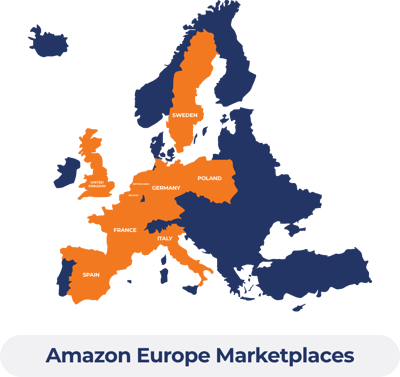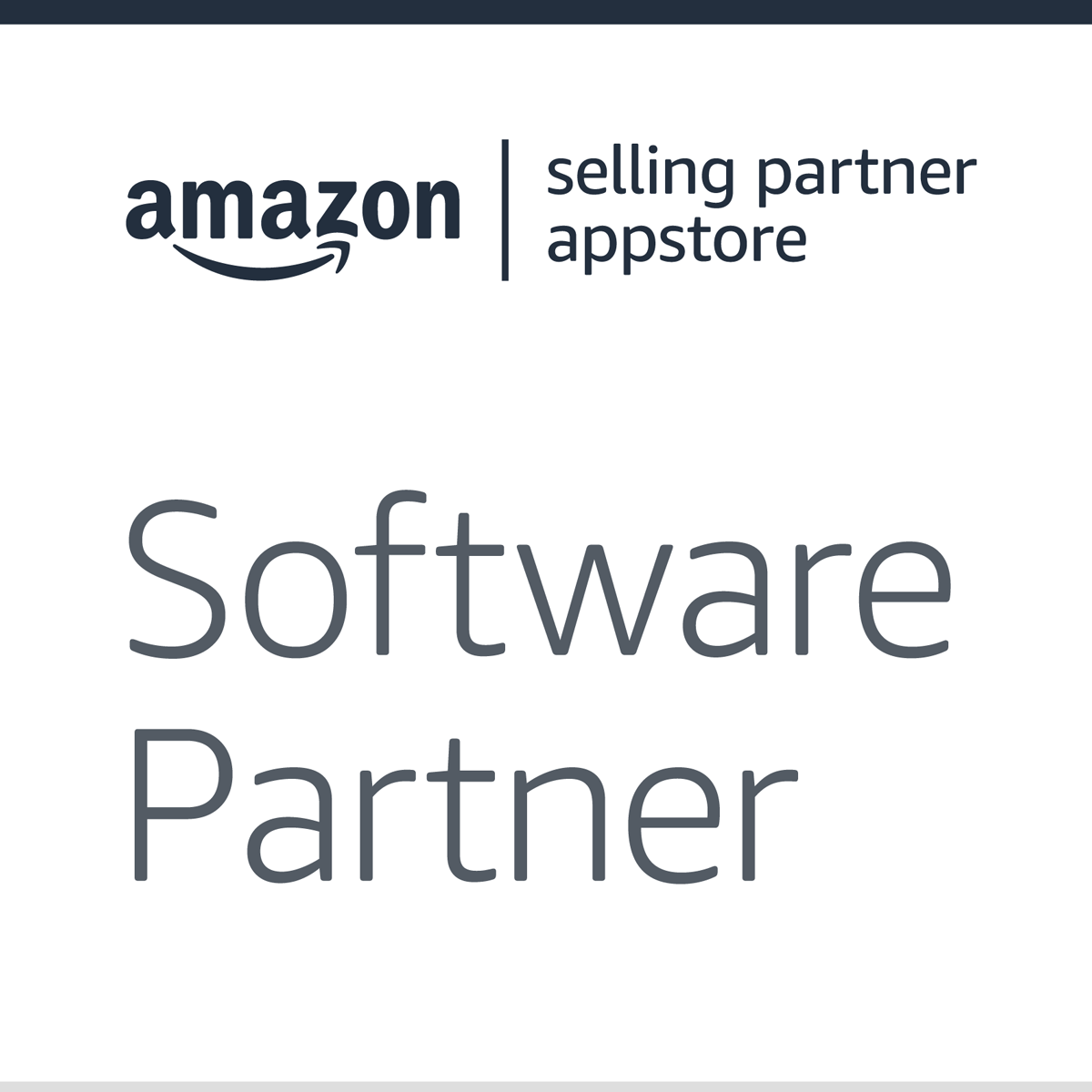Originally published on January 15, 2024, updated September 25, 2024
Menu
Join Our Email List
- Receive our monthly newsletter.
- Stay up to date on Amazon policies.
- Get tips to grow your business.
If you’ve conquered your local Amazon marketplace, expanding into the EU is an enticing prospect for many successful brands contemplating international growth. However, the complexities of selling on Amazon Europe, with its diverse marketplaces, languages, and regulations, require careful consideration. Whether you’re in the UK, US, or further afield, this guide delves into the crucial elements sellers and vendors must evaluate before embarking on their Amazon Europe journey.
Whilst the term ‘Amazon Europe’ is commonly used, the reality is far more intricate. Selling on Amazon Europe requires engaging with nine distinct marketplaces, each with its specific language, culture, and nuances. Amazon Europe encompasses the United Kingdom, Germany, France, Italy, Spain, the Netherlands, Poland, Belgium, and Sweden, with the potential for more additions in the future.
 Before diving into the European market, sellers and vendors must assess the feasibility of that diversification. Key considerations include identifying a suitable marketplace, gauging product demand, examining market competitiveness, and ensuring brand compatibility with the target demographic.
Before diving into the European market, sellers and vendors must assess the feasibility of that diversification. Key considerations include identifying a suitable marketplace, gauging product demand, examining market competitiveness, and ensuring brand compatibility with the target demographic.
Every seller and vendor must ask themselves the following questions:
Going into all nine countries simultaneously is a route we suggest you avoid. Doing so could consume all your resources and come at a high cost, potentially putting you off selling to Europe for life. We recommend taking baby steps and initially focusing on just one or two marketplaces. The largest marketplaces (and potentially the most profitable) are the UK and Germany, followed by France.
Before embarking on EU domination, you first need to ensure there is actual demand for your product in that market. Selling swimming pool filters in the UK, where few people have swimming pools, is probably not the best idea. Likewise, selling an electrical appliance with a US plug in the UK is a definite no-no, given the voltage and pins are different in mainland Europe and the UK. Do your research and see if there is A.) a genuine demand for your product and B.) make sure that your product or category is not restricted for sale on Amazon in that marketplace.
Next, you’ll need to check if there is a gap in the market for your product so that you’re not contributing to an already oversaturated category. Some countries are dominated by a few brands, making it difficult for new emerging brands to enter and take market share. Ask yourself if you have a point of difference substantial enough to compete in a new market with zero awareness of your brand.
A tricky one. Always double-check your brand name when translated into the language of the country you wish to sell in – make sure it doesn’t mean anything unfortunate that could hurt sales. Whilst Amazon doesn’t sell cars (yet), an amusing example is the Vauxhall Nova. ‘No va’, in Spanish, means ‘not going’, not quite the picture the brand wanted to paint, so they changed the name to Corsa to suit the Spanish market. Also, ensure that your brand has not already been registered as a European or UK trademark with another company.
Once you have identified demand, an opportunity to compete, and that your product and brand translate well, the next step is to look at operations, including product compliance, fulfilment, and tax obligations.
All sellers and vendors must understand the legal requirements for their product category and ensure they are country-specific and EU-compliant. There are also EU directives that businesses must adhere to depending on the category they sell in. For example, groceries need all labels written in the marketplace language they are sold in, CE markings are required for electronics and toys, and WEE legislation is essential for the disposal of electronic and electrical equipment. We recommend familiarising yourself with UK and EU consumer rights as these differ from the US and other international marketplaces.
To understand your legal tax obligation across the different countries in Europe, make sure you consult a tax advisor. A tax consultant will be able to identify which countries you need to be VAT registered in and assist you with the registration. The type of seller program you enroll in and where you hold inventory will also influence this. In addition, they can provide you with ongoing support when managing your VAT returns with the HMRC (tax office). They will also assist you in applying for an EORI number, which is requested when importing goods and paying customs in the UK and EU.
When it comes to selling in Europe, if you have been invited to become a vendor and have assessed that this is the best channel on Amazon for your business, you won’t need to choose the type of fulfilment program you use. Just set up the vendor account, and Amazon will raise orders you need to fulfil.
On the seller side, you will need to decide whether you want to manage orders via Fulfilment by Amazon (FBA), Merchant Fulfilled (MFN), or Seller Fulfilled Prime (SFP). If you select MFN, avoid fulfilling orders directly from the US and consider a third-party logistics business (3PL) in Europe. Although MFN from outside Europe is possible for some categories, there is a high risk of delays at customs, which could result in a negative customer experience, poor seller feedback, and not hitting certain seller performance metrics. If long-term you plan to go SFP, make sure you find a 3PL that can work towards the shipping requirements.
Going FBA is the easiest route and the option most international sellers launching in Europe will take. The three different FBA seller programs are:
Related reading: Amazon’s European Expansion Accelerator: Reach New Customers
Once you’ve got a handle on the operational side of things, your next focus should be your listings. When setting up your products on the seller side, you can do this in two ways: using the Build International Listings (BIL) tool within Seller Central or setting them up from scratch. The BIL tool helps you create and update your product listings from one marketplace to another. This method will save you time by managing everything from one marketplace; however, it’s worth noting that we have yet to see this run as smoothly as it sounds. Attempts by the machine-based tool to translate listings will often result in less-than-accurate interpretations.
In our experience, it’s always preferable to take the manual approach and avoid the automated tool when dealing with Europe. It may take longer, but it guarantees greater accuracy and control over the content and pricing. Not all countries have the same browse structure and categorisation, so it is good to own where the items sit from day one. That’s not to say you shouldn’t use the tool; it just depends on how you want to manage this aspect of your EU expansion.
Finally, and rather crucially, whilst your Amazon content may be fully optimised in your local country, it’s essential to factor in time and budget to get optimised content rolled out to all relevant countries. If your translations aren’t optimised correctly, your products won’t rank for certain keywords, and you will miss out on potential sales. It’s not safe to assume that everyone speaks English or that machine-based translations will suffice. A slap-dash approach also puts you at risk of potential errors in the content that could result in a negative customer experience and poor reviews.
Build your Amazon reputation with FeedbackFive, which allows you to automatically request reviews and seller feedback from buyers in 17 marketplaces. Getting reviews in the marketplaces you're selling in is an important way to increase buyer confidence, which can help increase conversions.
Local personalisation and optimisation are non-negotiable. You need to optimise your listings for search in each country so that they perform as best as they can. This means tapping into local search terms so that customers can find your products. Use native translators proficient in that language to translate and localise all product content. This includes the UK, as many colloquialisms in the US do not translate well in the UK.
The process of localisation includes keyword research. Keywords do not always translate well into another language. There could be numerous ways to name a product in one language that won’t be captured from a direct translation. Ensure your translators use keyword research tools to conduct country-specific keyword research to ensure your copy is fully optimised for SEO.
When translating and localising text, it’s also important to consider your images, graphics, and video content. A+ content and videos are managed at the country level so that they can be amended in one country and not impact another. Images, however, are global, so if you change an image in one marketplace, it will change for all other marketplaces. However, Amazon has recently opened up a tool that allows vendors and sellers to upload images at the local level. This is available in Vendor Central and is rolling out to brand owners on the seller side.
Top tip: to maintain a consistent brand image, we recommend optimising the content in the source marketplace and using that content as the base for your translation and localisation work. Don’t rewrite copy for every marketplace, as this can result in inconsistencies, missing information, and different tones of voice.
Selling in the EU is no small endeavor. However, Amazon has a lot of great resources available to sellers and vendors to simplify the process. As usual, doing your homework beforehand is critical.
If the prospect of selling on Amazon Europe still has you feeling like your business plan got lost in translation, fear not! eCommerce Nurse is on hand to interpret the jargon and smooth the rough seas on your journey to becoming a successful and truly international seller.
Originally published on January 15, 2024, updated September 25, 2024
This post is accurate as of the date of publication. Some features and information may have changed due to product updates or Amazon policy changes.
These Stories on International
14321 Winter Breeze Drive
Suite 121 Midlothian, VA 23113
Call us: 800-757-6840





Copyright© 2007-2025 eComEngine, LLC. All Rights Reserved. eComEngine®, FeedbackFive®, RestockPro®, and SellerPulse® are trademarks or registered trademarks of eComEngine, LLC. Amazon's trademark is used under license from Amazon.com, Inc. or its affiliates.
No Comments Yet
Let us know what you think